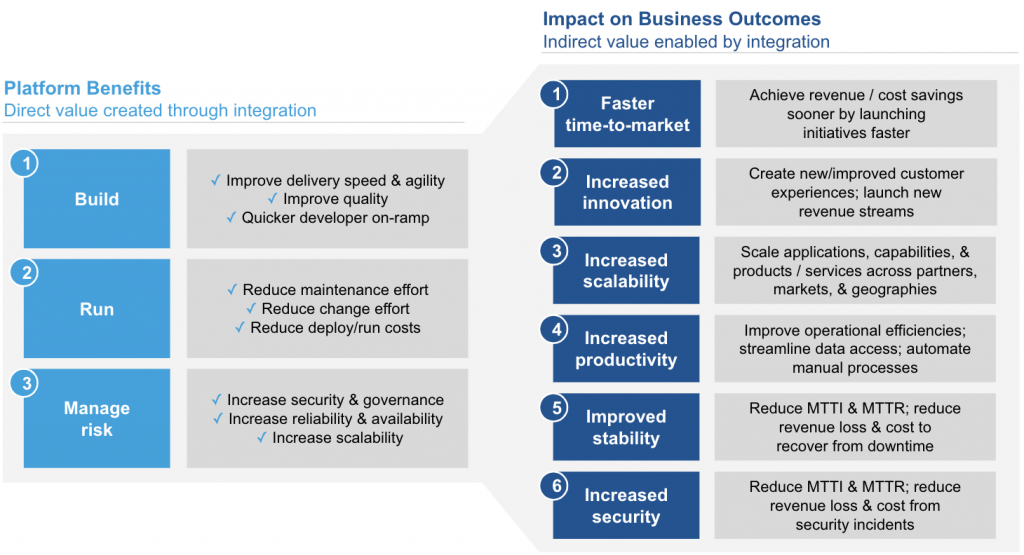The “integration apathy” problem
I meet with IT leaders regularly. We talk about everything from digital trends to transformation objectives to what’s happening behind them in our Zoom meeting. When I meet with these leaders, I often hear a common message:
“The business doesn’t care how we integrate, they just want results.”
A statement like this is a bit of a conundrum because, well, it can be both good and bad.
It’s good in that business leaders should focus on impact and business outcomes, rather than what integration technologies are being used or how their applications, data, and processes are orchestrated. They don’t care how the sausage is made, so to speak, they just care if it tastes good.
But it’s also bad because as a result of business leaders’ integration apathy, integration is often severely underfunded. Let me clarify — organizations globally spend nearly one trillion dollars on integration annually, according to Forrester’s latest forecast. So, it’s not that integration at large is underfunded, but rather, integration strategy that is.
Without a jointly developed integration strategy with both IT and the business involved, bad things happen — integration becomes a tactical decision point, solving for short-term needs at the expense of long-term value creation. I’m not pontificating for business leaders to understand the intricacies of integration technology – that’s still IT’s job. But, business leaders do need to understand the tradeoffs being made if one integration decision is being made over another, as these decisions have material, although often hidden, impact to your top- and bottom-line.
We need to go digital. Now what?
It’s not breaking news that companies today face enormous pressures to digitally transform; according to McKinsey, 65% of customer interactions are now digital. But despite organizations’ embrace of “going digital,” the majority of transformations fail because of an inability to quickly integrate data, applications, and business processes. For example, MuleSoft’s connectivity benchmark report shows that only 18% of organizations completely integrate end-user experiences as a result of data silos, legacy technologies, and point-to-point architectures.
A digital transformation strategy is only going to be as successful as the integration strategy that underpins it. Companies that are successful in their transformation pursuits all have one thing in common — they embrace a “digital mindset.” As Jeff Lawson, CEO and Founder of Twilio recently wrote, successful companies view their software as a competitive advantage, treating it as a core competency and thus investing the time, resources, and capital to cultivate it. “In the digital economy,” Lawson writes, “whoever builds the best software wins.”
You can’t have transformation without integration
A digital mindset shift for business and IT leaders also means adopting a strategic view of integration. Fundamental to this shift is the adoption of application programming interfaces (APIs), the building blocks of any modern integration approach.
APIs have become a boardroom topic of late, and there are many reasons why. Multiple studies show the impact APIs can have, with one showing they can increase market capitalization by 4 – 10%, another showing an increase to market value to be upwards of 20%. Generating this type of impact from APIs won’t come by accident. Enter: “modern integration”, which I’ll define as a business-focused integration strategy + operating model + an API & integration lifecycle technology platform.

Figure 1: Three key elements to modern integration
When these three elements are addressed, you’ve set yourself up for transformative success.
Modern integration and sources of value
To reap the benefits from modern integration, and from APIs specifically, you don’t need to be a technology company. Nor do you need to directly monetize your APIs. In fact, most APIs that are developed are solely for internal organizational use. So whether or not you’re directly monetizing your APIs, it’s important to understand the value creation opportunities so you can direct investments appropriately.
However, organizations often find it difficult to put a value on integration. We have a framework to help you. The framework is two parts: Platform Benefits – the IT value created by modern integration, and Business Outcomes – the business value enabled by modern integration.

Figure 2: Modern integration creates both IT and business value
While the platform benefits and associated IT value is important and significant, from a “dollar and cents” perspective, it’s often pennies on the dollar when compared to the business value modern integration enables. In this blog series, I’ll focus on the right side of the framework and review each of the six business sources of value in detail. In my next post, I’ll dive into faster time-to-market and the significant impact delivering integration faster can have on your next business initiative.









